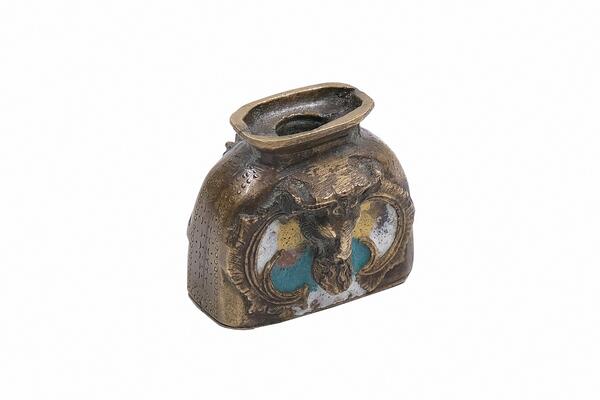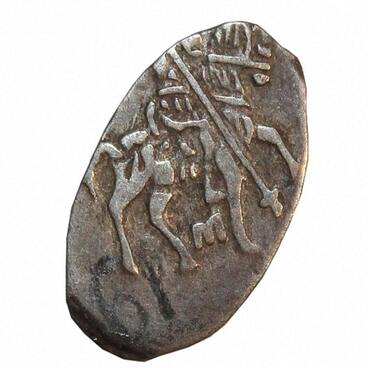An inkwell is a small vessel for storing liquid ink. In the times when people wrote with quills, it played a prominent role in the everyday life. In the Middle Ages, black ink from soot and coal was used in Ancient Rus, as well as red-brown or brown-black from a special chemical compound based on iron sulfate — for that, it was called ferruginous.
Mostly people preferred to write with goose quills. As a rule, the quill was removed from the bird’s left wing so that the bend was convenient for the right hand. It was degreased by sticking it into the hot sand, then an oblique cut was made at the tip, which then was split and sharpened with a special penknife.
The inkwell from the museum’s collection closely resembles a four-sided shtof-bottle with a short neck. The only difference is that it is flatter and with an expanded neck in the form of a cone, through which excess ink could flow back. This form is stable and convenient in everyday use: the inkwell could be fastened at the waist, put on any surface or simply held on the palm of the hand.
There is a textured image on both sides of it. It resembles the head of an animal with horns and a beard. Judging by the enamel pattern, the image looks like a ram’s head with twisted horns.
The master made an inkwell in the technique of copper casting. Casting is one of the oldest ways of processing metals. Most likely, it appeared in the 5th — 3rd millennia BC. People used the casting technique to make household utensils, tools, weapons, and jewelry, most often from copper and its alloys, especially bronze — a compound of copper and tin, and later brass — an alloy of copper and zinc.
Workshops that specialized in casting objects from copper were called coppersmiths’. The largest Old Believer center of the copper casting was in Pomorye — the northern part of the country, which nowadays includes the Arkhangelsk Region, the Nenets Autonomous District, the Komi Republic, the Republic of Karelia and the Murmansk Region either partially or completely. In 1695, in the remote forests on the Vyg River (the territory of present-day Karelia), the Old Believers founded Vygo-Leksinsky (or Danilov) monastery, which became famous for its copper foundry production. It mainly focused on items of religious worship, such as crosses, icons, folding icons. Sometimes there were also household utensils made there like inkwells.
Mostly people preferred to write with goose quills. As a rule, the quill was removed from the bird’s left wing so that the bend was convenient for the right hand. It was degreased by sticking it into the hot sand, then an oblique cut was made at the tip, which then was split and sharpened with a special penknife.
The inkwell from the museum’s collection closely resembles a four-sided shtof-bottle with a short neck. The only difference is that it is flatter and with an expanded neck in the form of a cone, through which excess ink could flow back. This form is stable and convenient in everyday use: the inkwell could be fastened at the waist, put on any surface or simply held on the palm of the hand.
There is a textured image on both sides of it. It resembles the head of an animal with horns and a beard. Judging by the enamel pattern, the image looks like a ram’s head with twisted horns.
The master made an inkwell in the technique of copper casting. Casting is one of the oldest ways of processing metals. Most likely, it appeared in the 5th — 3rd millennia BC. People used the casting technique to make household utensils, tools, weapons, and jewelry, most often from copper and its alloys, especially bronze — a compound of copper and tin, and later brass — an alloy of copper and zinc.
Workshops that specialized in casting objects from copper were called coppersmiths’. The largest Old Believer center of the copper casting was in Pomorye — the northern part of the country, which nowadays includes the Arkhangelsk Region, the Nenets Autonomous District, the Komi Republic, the Republic of Karelia and the Murmansk Region either partially or completely. In 1695, in the remote forests on the Vyg River (the territory of present-day Karelia), the Old Believers founded Vygo-Leksinsky (or Danilov) monastery, which became famous for its copper foundry production. It mainly focused on items of religious worship, such as crosses, icons, folding icons. Sometimes there were also household utensils made there like inkwells.



